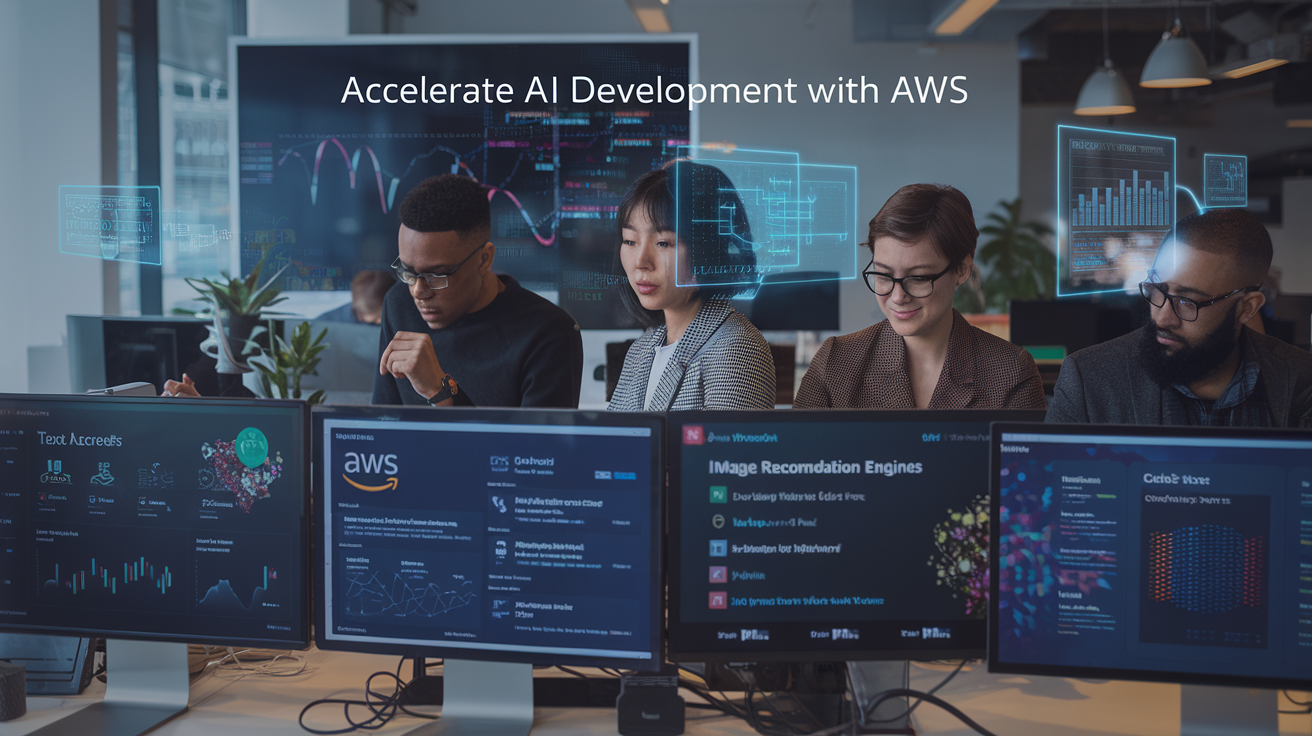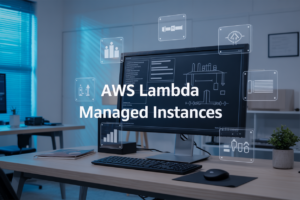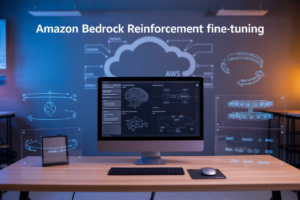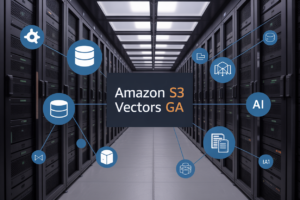Ever spent weeks coding a basic recommendation feature only to watch a competitor release something ten times better while you were still debugging? Yeah, that’s the AI implementation gap that keeps dev teams up at night.
AWS managed AI services are changing this game completely. You can now build sophisticated AI capabilities into your apps without a team of data scientists or months of development time.
The beauty of AWS managed AI services lies in their accessibility—they transform complex machine learning operations into simple API calls that any developer can implement. Whether you’re handling image recognition, natural language processing, or personalized recommendations, there’s a ready-to-deploy solution waiting.
But which services actually deliver on their promises, and which ones leave you with more technical debt than solutions?
Understanding AWS Managed AI Services

The Competitive Edge of AWS in the AI Landscape
AWS crushes competitors in the AI arena with unmatched scale and integration. Their services aren’t just powerful—they’re ridiculously easy to implement. While Google and Azure scramble to catch up, AWS keeps rolling out innovations that make developers’ lives simpler and businesses smarter. The ecosystem plays nice with existing AWS deployments, creating a “why would you go anywhere else?” situation.
How Managed Services Accelerate Development Timelines
Gone are the days of building AI capabilities from scratch. AWS managed services slash development time from months to days—sometimes even hours. Your team can focus on creating business value instead of wrestling with infrastructure headaches. Plus, these services come pre-optimized, so you’re not wasting precious weeks fine-tuning algorithms that AWS engineers have already perfected.
Cost Benefits: Build vs. Buy Analysis for AI Implementation
Building in-house AI infrastructure? Get ready for sticker shock:
| Build In-House | AWS Managed Services |
|---|---|
| $500K+ upfront | Pay-as-you-go pricing |
| 6-12 month timeline | Immediate deployment |
| Ongoing maintenance costs | Automatic updates included |
| Specialized AI talent required | Minimal specialized skills needed |
The math doesn’t lie—AWS managed services deliver ROI faster with dramatically lower risk.
Key Players in the AWS AI Service Ecosystem
The AWS AI family has something for every use case. Amazon Comprehend turns messy text into actionable insights. Rekognition transforms images into data gold mines. Lex powers conversational interfaces that don’t make customers want to scream. SageMaker democratizes machine learning for the masses. And Forecast predicts the future better than your company’s most seasoned analysts.
Amazon Comprehend: Unlocking Text Analysis Power

Extracting Valuable Insights from Unstructured Text
Amazon Comprehend cuts through the noise in your text data like a hot knife through butter. It doesn’t just read—it understands context, identifies patterns, and pulls out meaningful insights from mountains of unstructured text. Customer emails, social media posts, product reviews—they’re all gold mines of intelligence when Comprehend gets its hands on them.
Real-time Sentiment Analysis for Customer Feedback
Ever wished you could instantly know how customers feel about your product? That’s Comprehend’s superpower. It analyzes feedback in real-time, detecting not just positive or negative sentiment but also nuanced emotions like frustration, excitement, or confusion. This isn’t just neat—it’s business-critical for brands that need to address issues before they snowball.
Entity Recognition Capabilities for Data Processing
Comprehend spots the needles in your haystack of text data. Names, dates, locations, organizations—it automatically tags them all without breaking a sweat. Think about processing thousands of medical records to identify treatments, symptoms, and medications, or scanning legal documents to extract relevant parties and terms. The manual alternative? Don’t even think about it.
Industry-Specific Use Cases and Success Stories
Financial services firms use Comprehend to scan earnings calls for market signals. Healthcare providers deploy it to extract critical information from patient records. Media companies leverage it to automatically tag and organize content libraries. One streaming service increased content discovery by 35% after implementing Comprehend to analyze viewer comments and improve their recommendation engine.
Implementation Best Practices for Optimal Results
Start small with a focused use case before scaling. Clean your training data—garbage in means garbage out. Use Comprehend’s custom classification for industry-specific terminology. Monitor performance regularly and retrain models as needed. And remember: the API makes integration simple, but thoughtful implementation makes it powerful.
Amazon Rekognition: Vision Intelligence Made Simple

Amazon Rekognition: Vision Intelligence Made Simple
A. Image and Video Analysis Without ML Expertise
Ever tried building computer vision into your app? It’s typically a nightmare of complex ML models and data science headaches. But AWS Rekognition changes everything. You simply send images or videos to the API, and boom—detailed analysis comes back instantly. No PhD required, just straightforward integration that lets developers with zero ML background add powerful vision capabilities to their applications.
B. Facial Analysis and Recognition Features
Rekognition doesn’t just see images—it understands faces in ways that’ll blow your mind. Need to detect emotions in customer photos? Done. Want to verify identity through selfies? Easy. The service identifies age ranges, emotions, and even tracks faces across video frames. And unlike building this yourself (which would take months), Rekognition handles all the heavy lifting while you focus on creating experiences your users will love.
C. Content Moderation for Safer Applications
Content moderation used to be a manual nightmare. Not anymore. Rekognition automatically detects inappropriate, unwanted, or offensive content in images and videos, giving you confidence to build platforms where user-generated content flows freely. Set your own thresholds for categories like nudity, violence, or alcohol, and let the service handle the rest—protecting your brand and users without human reviewers burning out.
D. Integration Patterns with Other AWS Services
The real magic happens when Rekognition joins forces with other AWS services. Pair it with S3 for automatic tagging of uploaded media. Connect it to Lambda for serverless image processing workflows. Feed analysis results into DynamoDB to make content searchable by visual attributes. The possibilities are endless, creating intelligent systems that see, understand, and act on visual information across your entire application ecosystem.
Amazon Lex: Conversational Interfaces in Days, Not Months

Amazon Lex: Conversational Interfaces in Days, Not Months
Building Sophisticated Chatbots Without NLP Expertise
Want to build a chatbot but don’t have a PhD in natural language processing? Amazon Lex has your back. This powerhouse service handles all the complex NLP heavy lifting so you can focus on designing conversations that feel natural. The drag-and-drop interface means your team can build, test, and deploy conversational bots in days instead of the months typically required with traditional development approaches.
Voice and Text Bot Integration Strategies
Integrating voice and text interfaces shouldn’t feel like rocket science. Lex makes it surprisingly straightforward with unified processing for both channels. You can design once and deploy everywhere—mobile apps, websites, messaging platforms, and even IoT devices. The real magic happens when you combine them, creating seamless experiences where users can start with text and switch to voice mid-conversation.
Seamless Handoff to Human Agents
No bot can handle everything. Smart developers know when to bring in the humans. Lex’s agent handoff capabilities detect when a conversation has reached its AI limits and smoothly transitions to human support. The best part? All conversation context travels with the handoff, so your support team starts with complete customer history instead of making users repeat themselves.
Multilingual Support for Global Applications
Going global? Lex speaks your customers’ language—literally. The service supports multiple languages and regional dialects out of the box, making international expansion dramatically simpler. One dashboard lets you manage all your language variants while maintaining consistent business logic. The translation happens behind the scenes, letting you focus on creating value rather than managing linguistic complexities.
Amazon Personalize: Recommendation Systems at Scale

Amazon Personalize: Recommendation Systems at Scale
A. Implementing Netflix-Style Recommendations with Minimal Data Science
Ever tried building a recommendation engine from scratch? Nightmare city. Amazon Personalize gives you Netflix-level recommendation power without the PhD requirement. Upload your interaction data, define a few business goals, and boom – personalized product suggestions that actually convert. No more guessing what your customers want.
B. Real-time Personalization Strategies
Real-time personalization isn’t just fancy tech jargon – it’s your secret weapon for boosting conversions. With Personalize, you can instantly adapt to user behavior as it happens. Someone clicks on running shoes? Show them related gear immediately, not tomorrow when they’ve already bought elsewhere. This dynamic approach keeps users engaged and spending.
C. Cold-Start Problem Solutions
The cold-start problem haunts every recommendation system. New users? Zero history. New products? No data. Personalize tackles this head-on with item metadata integration and smart default strategies. It blends content-based approaches with collaborative filtering, so even first-time visitors get surprisingly relevant recommendations instead of random products nobody wants.
D. Measuring ROI on Personalization Efforts
Personalization sounds great, but does it actually make money? Personalize makes measuring impact straightforward with built-in metrics tracking. Companies typically see 10-30% revenue lift from well-implemented recommendation systems. The platform’s A/B testing capabilities let you compare personalized vs. generic experiences, proving the business case beyond just vanity metrics.
Amazon Forecast: Predictive Analytics for Business Planning

Time-Series Forecasting Made Accessible
Amazon Forecast removes the complexity from predictive analytics. No more wrestling with statistical models or hiring specialized data scientists. Simply upload your historical data, and AWS’s deep learning algorithms do the heavy lifting, delivering forecasts that are typically 50% more accurate than traditional methods. It’s like having a crystal ball for your business decisions.
Inventory Optimization Use Cases
Retailers are crushing their inventory game with Amazon Forecast. Imagine slashing overstock costs while maintaining perfect product availability. That’s exactly what companies like Zalando achieved—reducing excess inventory by 15% and stockouts by 20%. Manufacturing giants use it to optimize raw materials, while healthcare providers forecast supply needs with scary accuracy.
Demand Planning Implementation Steps
Getting started with Amazon Forecast isn’t rocket science:
- Prepare your historical data (minimum 2 years recommended)
- Import into Amazon Forecast
- Configure forecast parameters
- Train your predictor model
- Generate and evaluate forecasts
- Integrate predictions into your planning systems
Most businesses see actionable results within weeks, not months.
Implementation Roadmap for AWS AI Services

Implementation Roadmap for AWS AI Services
A. Choosing the Right Services for Your Use Case
Picking the perfect AWS AI service isn’t rocket science, but it does require some homework. Start by clearly defining your problem – are you analyzing text, processing images, or building a chatbot? Match your use case to AWS’s specialized tools rather than forcing a square peg into a round hole. Remember, sometimes combining services creates the most powerful solution.
B. Authentication and Security Best Practices
AWS AI services handle sensitive data, so locking down security isn’t optional. Implement IAM roles with least privilege principles from day one. Use temporary credentials instead of hardcoded keys. Enable encryption for data at rest and in transit. Consider AWS PrivateLink for sensitive workloads to keep traffic off the public internet. Regularly audit permissions to catch any access drift.
C. Cost Optimization Strategies
Nobody likes surprise bills. AWS AI services price differently – some charge per API call, others by data processed. Start with reserved capacity for predictable workloads and on-demand for variable ones. Cache results when possible to avoid redundant processing. Implement request throttling to prevent runaway costs. Set up AWS Budgets with alerts before things get out of hand. Remember, the cheapest service isn’t always the most cost-effective.
D. Scaling Considerations for Production Deployment
AWS AI services handle scaling automatically, but your architecture around them needs careful planning. Build with asynchronous processing patterns to handle traffic spikes. Implement retry logic with exponential backoff for service throttling. Consider multi-region deployments for critical workloads. Use AWS Application Auto Scaling to adjust provisioned throughput based on demand patterns, especially for services like Rekognition or Comprehend.
E. Monitoring and Maintenance Approaches
Flying blind with AI services is asking for trouble. Set up CloudWatch dashboards tracking latency, error rates, and usage metrics. Create alarms for abnormal patterns like sudden accuracy drops. Log inference results for post-analysis and debugging. Schedule regular model evaluations as your data evolves. Implement canary deployments when updating critical AI components. Remember, even “managed” services require vigilance to maintain optimal performance.
Integration Patterns and Architectures

Integration Patterns and Architectures
A. Serverless AI Applications with Lambda
Ever tried building AI apps that don’t make you worry about servers? AWS Lambda is your secret weapon here. Write your code, upload it, and boom—Lambda handles everything else while you connect to Amazon Rekognition, Comprehend, or any other AI service through simple API calls. No infrastructure headaches, just pure AI power.
B. Container-Based AI Workflows
Containers are game-changers for complex AI workloads. With Amazon ECS or EKS, you can package your AI application with all its dependencies and deploy consistently across environments. Need to run that custom TensorFlow model alongside AWS Personalize? Containers make it happen with predictable performance regardless of where they run.
C. Hybrid Approaches with Custom Models
Sometimes you need both AWS managed services and your own secret sauce. The hybrid approach lets you combine pre-built AI capabilities like Amazon Forecast with your custom PyTorch models running on SageMaker. This gives you the best of both worlds—rapid development from managed services plus competitive edge from proprietary algorithms.
D. Data Pipeline Considerations
Your AI is only as good as the data feeding it. Design pipelines that handle real-time and batch processing using services like Kinesis for streaming data or Glue for ETL jobs. The smartest architectures separate data ingestion from processing, giving you flexibility to evolve your AI capabilities without rebuilding your entire infrastructure.
Future-Proofing Your AI Strategy with AWS

Future-Proofing Your AI Strategy with AWS
A. Staying Current with Rapid AI Advancements
AWS isn’t just keeping pace with AI—they’re often leading the charge. Their continuous release cycle means you’re never stuck with yesterday’s tech. Want proof? Just look at how quickly they integrated GPT capabilities after ChatGPT exploded onto the scene. They don’t make you wait for innovation.
B. Migration Paths as Your Needs Evolve
Your AI needs today? Probably different tomorrow. AWS gets this. Their managed services are designed with smooth upgrade paths, letting you start simple with services like Comprehend for basic text analysis, then seamlessly scale to more sophisticated implementations as your use cases mature. No painful rebuilds required.
C. Balancing Managed Services vs. Custom Development
The million-dollar question: build or buy? AWS offers a sweet spot. Their managed services handle the heavy lifting (infrastructure, scaling, security), while still giving you hooks to customize what matters. The trick is knowing when to use SageMaker for that custom model versus when Amazon Rekognition’s pre-built vision AI will do the job perfectly.
D. Emerging AI Services to Watch
Keep your eyes on AWS Bedrock—it’s changing how companies deploy foundation models without massive investments. Also watch Amazon Q (their AI assistant for developers) and their expanding multimodal capabilities. The real game-changers aren’t just new services but how AWS is making existing services work together in more intelligent ways.

The AWS Managed AI Services ecosystem offers a transformative approach to application development, enabling businesses of all sizes to incorporate sophisticated AI capabilities without the traditional barriers of expertise and resources. From text analysis with Amazon Comprehend to visual intelligence through Rekognition, conversational interfaces via Lex, personalized recommendations with Personalize, and predictive analytics through Forecast, these services provide ready-to-deploy solutions that can be integrated through well-established patterns and architectures.
As you embark on your AI journey with AWS, remember that the true power lies in starting small, focusing on specific business problems, and scaling gradually. By leveraging these managed services, you can not only accelerate your time-to-market but also future-proof your applications against the rapidly evolving AI landscape. The question is no longer whether to incorporate AI into your applications, but how quickly you can harness these tools to create intelligent experiences that delight your users and drive business value.



















